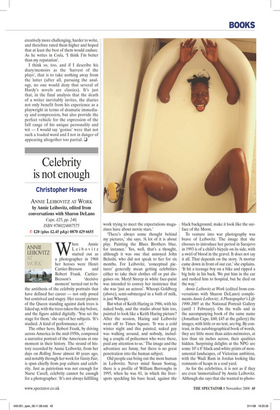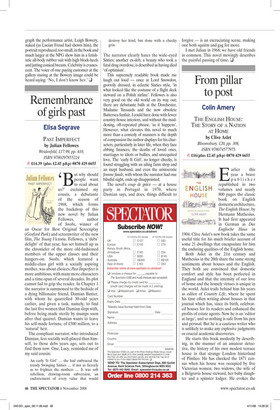Celebrity is not enough
Christopher Howse
annie leiBovitz at Work by Annie Leibovitz, edited from conversations with Sharon DeLano Cape, £25, pp. 240, ISBN 9780224087575 ✆ £20 (plus £2.45 p&p) 0870 429 6655 When Annie Leibovitz started out as a photographer in 1968 her heroes were Henri Cartier-Bresson and Robert Frank. Cartier Bresson’s ‘decisive moment’ turned out to be the antithesis of the celebrity portraits that have defined her career — not only posed but contrived and stagey. Her recent picture of the Queen standing against dark trees is faked up, with the trees taken the day before, and the figure added digitally. ‘You set the stage for them,’ she says of her subjects. ‘It’s studied. A kind of performance art.’ The other hero, Robert Frank, by driving across America in the mid-1950s, composed a narrative portrait of the Americans at one moment in their history. The strand of history recorded by Annie Leibovitz, from her days on Rolling Stone almost 40 years ago, and notably through her work for Vanity Fair, is spun chiefly from pop culture and celebrity. Just as patriotism was not enough for Nurse Cavell, celebrity cannot be enough for a photographer. ‘It’s not always fulfilling work trying to meet the expectations magazines have about movie stars.’ ‘There’s always some thought behind my pictures,’ she says. ‘A lot of it is about play. Painting the Blues Brothers blue, for instance.’ Yes, well, that’s a thought, although it was one that annoyed John Belushi, who did not speak to her for six months. For Leibovitz, ‘conceptual pictures’ generally mean getting celebrities either to take their clothes off or put disguises on. Meryl Streep in white face-paint was intended to convey her insistence that she was ‘just an actress’. Whoopi Goldberg (above), semi-submerged in a bath of milk, is just Whoopi.
But what of Keith Haring in 1986, with his naked body, and the studio about him too, painted to look like a Keith Haring picture? After the session, Haring and Leibovitz went off to Times Square. ‘It was a cold winter night and this painted, naked guy was walking around, and nobody, including a couple of policemen who were there, paid any attention to us.’ The image and the adventure are funny, but there is no great penetration into the human subject.
Old people can bring out the most human in Leibovitz. Never mind Susan Sontag, there is a profile of William Burroughs in 1995, when he was 81, in which the liverspots speckling his bare head, against the black background, make it look like the surface of the Moon.
To venture into war photography was brave of Leibovitz. The image that she chooses to introduce her period in Sarajevo in 1993 is of a child’s bicycle on its side, with a swirl of blood in the gravel. It does not say it all. That depends on the story. ‘A mortar came down in front of our car,’ she explains. ‘It hit a teenage boy on a bike and ripped a big hole in his back. We put him in the car and rushed him to hospital, but he died on the way.’ Annie Leibovitz at Work (edited from conversations with Sharon DeLano) complements Annie Leibovitz: A Photographer’s Life 1990-2005 at the National Portrait Gallery (until 1 February). On the walls and in the accompanying book of the same name (Jonathan Cape, £60; £45 at the gallery) the images, with little or no text, are big. By contrast, in the autobiographical book of words, they are little more than aides-mémoires, at less than six inches across, their qualities hidden. Surprising delights at the NPG are some 10’ x 8’ black-and-white prints of monumental landscapes, of Victorian ambition, with the Wadi Rum in Jordan looking like remnants of heaps in a coal yard.
As for the celebrities, it is not as if they are even ‘immortalised’ by Annie Leibovitz. Although she says that she wanted to photo graph the performance artist, Leigh Bowery, naked (as Lucian Freud had shown him), the portrait reproduced, too small, in the book and much larger at the NPG show him in a fetishistic all-body rubber suit with high block-heels and jutting conical breasts. Celebrity is evanescent. The voice of one paying customer at the gallery staring at the Bowery image could be heard saying: ‘No, I don’t know her.’ ❑



















































































 Previous page
Previous page